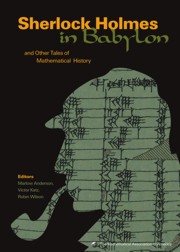Book contents
- Frontmatter
- Introduction
- Contents
- Ancient Mathematics
- Medieval and Renaissance Mathematics
- The Seventeenth Century
- Foreword
- An Application of Geography to Mathematics: History of the Integral of the Secant
- Some Historical Notes on the Cycloid
- Descartes and Problem-Solving
- René Descartes' Curve-Drawing Devices: Experiments in the Relations Between Mechanical Motion and Symbolic Language
- Certain Mathematical Achievements of James Gregory
- The Changing Concept of Change: The Derivative from Fermat to Weierstrass
- The Crooked Made Straight: Roberval and Newton on Tangents
- On the Discovery of the Logarithmic Series and Its Development in England up to Cotes
- Isaac Newton: Man, Myth, and Mathematics
- Reading the Master: Newton and the Birth of Celestial Mechanics
- Newton as an Originator of Polar Coordinates
- Newton's Method for Resolving Affected Equations
- A Contribution of Leibniz to the History of Complex Numbers
- Functions of a Curve: Leibniz's Original Notion of Functions and Its Meaning for the Parabola
- Afterword
- The Eighteenth Century
- Index
- About the Editors
Certain Mathematical Achievements of James Gregory
from The Seventeenth Century
- Frontmatter
- Introduction
- Contents
- Ancient Mathematics
- Medieval and Renaissance Mathematics
- The Seventeenth Century
- Foreword
- An Application of Geography to Mathematics: History of the Integral of the Secant
- Some Historical Notes on the Cycloid
- Descartes and Problem-Solving
- René Descartes' Curve-Drawing Devices: Experiments in the Relations Between Mechanical Motion and Symbolic Language
- Certain Mathematical Achievements of James Gregory
- The Changing Concept of Change: The Derivative from Fermat to Weierstrass
- The Crooked Made Straight: Roberval and Newton on Tangents
- On the Discovery of the Logarithmic Series and Its Development in England up to Cotes
- Isaac Newton: Man, Myth, and Mathematics
- Reading the Master: Newton and the Birth of Celestial Mechanics
- Newton as an Originator of Polar Coordinates
- Newton's Method for Resolving Affected Equations
- A Contribution of Leibniz to the History of Complex Numbers
- Functions of a Curve: Leibniz's Original Notion of Functions and Its Meaning for the Parabola
- Afterword
- The Eighteenth Century
- Index
- About the Editors
Summary
For a long time the light of James Gregory did not shine as brightly as did that of John Wallis, Isaac Barrow and Isaac Newton, the other three great British mathematicians of the seventeenth century. Only recently, through the endeavors of several Scottish mathematicians, especially E. T. Whittaker, G. A. Gibson and H. W. Turnbull, Gregory's genius is revealed and fills with admiration all those interested in the development of modern mathematics.
The James Gregory Tercentenary Memorial Volume, edited by H. W. Turnbull [1], contains Gregory's momentous scientific correspondence, mostly with J. Collins. An extremely important supplement is the large number of Gregory's hitherto unpublished notes, recording his mathematical ideas and calculations. These notes were found in a collection of documents in the University of St. Andrews Library, written on the blank spaces of letters to Gregory. This material affords the possibility of studying his achievements and ideas.
In this paper we shall discuss Gregory's expansions of general and particular functions into series. In addition, we shall exhibit the ideas which are set forth in his first mathematical publication Vera circuli et hyperbolae quadratura [2]. These ideas are concerned, to some extent, with the associated problem of constructing by certain limiting processes the functions which measure the areas of circles and conics.
The “Taylor's series”
In a letter of February 15, 1671 to J. Collins (see Memorial [1], pp. 170 ff.) Gregory gives the power series for seven important functions, each with 5 or 6 terms.
- Type
- Chapter
- Information
- Sherlock Holmes in BabylonAnd Other Tales of Mathematical History, pp. 208 - 217Publisher: Mathematical Association of AmericaPrint publication year: 2003
- 1
- Cited by



